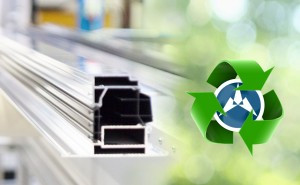Sturdiness has long been a crucial concern in the construction sector. It was linked to the mass of the used materials until the beginning of the 20th century. To put it bluntly: heavy building materials are good, lighter ones are not. This changes if it turns out that aluminium can just as easily guarantee sturdiness.

The rise and breakthrough of thermally insulated window profiles: The Empire State Building as catalyst
Aluminium was first used as a building material at the end of the 19th century, particularly as roofing and exterior wall covering. Aluminium window profiles only became popular in the 1920s and 1930s of the past century. The main catalyst is the rise of skyscrapers in the United States.
The architects of these ambitious building projects have a clear preference for a modern design with a lot of glass. They highlight aluminium as the ideal material for the window profiles. It is light but also very firm. This makes it possible to work with sleek, modern-looking windows.
The most famous and one of the first skyscrapers with aluminium window profiles is the Empire State Building in New York. The construction of this 381-metre-high office tower started on 17 March 1930 and the 102 stories were completed barely 410 days later. We can tell you that this iconic building has 6,514 windows, so you do not need to waste time counting them.
Energy crisis
The 1970s and 1980s were marked by an energy crisis and increasing environmental awareness. The high energy costs (heating in winter, cooling in summer) were studied. Researches found that aluminium window profiles are light and firm, but also a weak spot when it comes to thermal insulation. Large windows – often with single glazing – have a major influence on the indoor temperature, both in summer (heat) and in winter (cold).
The rise of double glazing after the Second World War is a first step in the right direction. But this does not solve the problem of the profiles. In the last quarter of the last century, a movement started which continuously – even now – looks for the ideal way of insulating aluminium window profiles. It was discovered that a thermal barrier in the middle of the profile is a good insulator. An insulating foam was inserted between the two extrusions of the aluminium window profile in the 1980s.
Plastic barrier
The R&D departments of the profile manufacturers continue to operate at full capacity. They determine that adding a plastic barrier (e.g. polyamide, PVC, ABS or Noryl) in the aluminium profile is an improvement over the polyurethane foam. It also improves the thermal insulation value so that these window profiles score at least as well as wood and PVC frames.
All these evolutions did not go by unnoticed by the owners of the Empire State Building. They decided in 1993 to replace all 6,514 windows of their skyscraper. An expensive project, but the men are well aware that they can easily recoup these costs thanks to the significant reduction in their energy costs.
- Peter De Roovere



Leave a comment